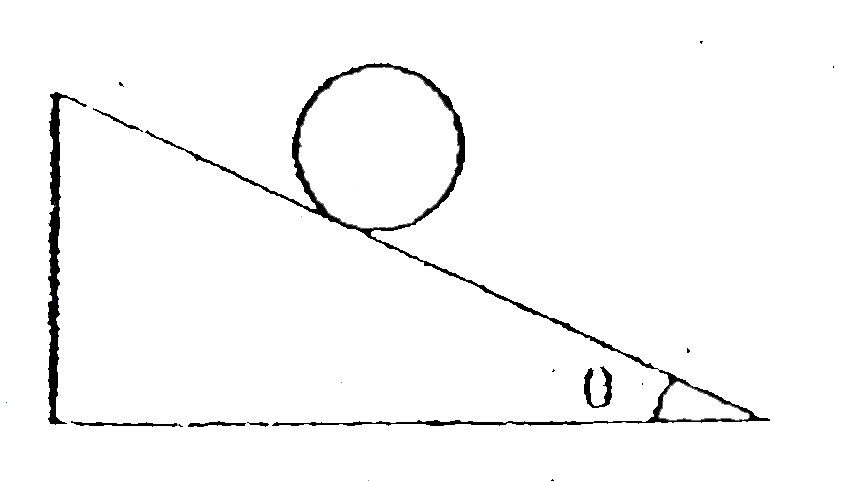A solid cylinder rolls down an inclined plane of height 3m and reaches the bottom of plane with angular velocity of 2√2rad/s. The radius of cylinder must be [take g=10m/s2]
5 cm
0.5 cm
√10 cm
√5 m
The correct Answer is:D
To solve the problem, we will use the principle of conservation of energy. The potential energy at the top of the inclined plane will convert into kinetic energy at the bottom.
1. Identify the initial potential energy (PE_initial):
The potential energy at the top of the incline can be calculated using the formula:
PEinitial=mgh
where:
- m = mass of the cylinder (we will see that it cancels out),
- g=10m/s2 (given),
- h=3m (height of the incline).
Thus,
PEinitial=mg⋅3
2. Identify the final kinetic energy (KE_final):
At the bottom of the incline, the cylinder has both translational and rotational kinetic energy. The total kinetic energy can be expressed as:
KEfinal=KEtranslational+KErotational
The translational kinetic energy is given by:
KEtranslational=12mv2cm
The rotational kinetic energy is given by:
KErotational=12Iω2
For a solid cylinder, the moment of inertia I is:
I=12mr2
Therefore,
KErotational=12(12mr2)ω2=14mr2ω2
3. Relate translational velocity and angular velocity:
Since the cylinder rolls without slipping, the relationship between the translational velocity vcm and angular velocity ω is:
vcm=rω
Therefore,
KEtranslational=12m(rω)2=12mr2ω2
4. Combine the kinetic energies:
Now substituting back into the total kinetic energy:
KEfinal=12mr2ω2+14mr2ω2=(12+14)mr2ω2=34mr2ω2
5. Set initial potential energy equal to final kinetic energy:
By conservation of energy:
mgh=KEfinal
Substituting the expressions we derived:
mg⋅3=34mr2ω2
Canceling m from both sides:
g⋅3=34r2ω2
6. Substituting known values:
We know g=10m/s2 and ω=2√2rad/s:
10⋅3=34r2(2√2)2
Simplifying:
30=34r2⋅8
30=6r2
r2=5
r=√5meters
Final Answer:
The radius of the cylinder must be √5meters.
The potential energy at the top of the incline can be calculated using the formula:
PEinitial=mgh
where:
- m = mass of the cylinder (we will see that it cancels out),
- g=10m/s2 (given),
- h=3m (height of the incline).
PEinitial=mg⋅3
At the bottom of the incline, the cylinder has both translational and rotational kinetic energy. The total kinetic energy can be expressed as:
KEfinal=KEtranslational+KErotational
The translational kinetic energy is given by:
KEtranslational=12mv2cm
The rotational kinetic energy is given by:
KErotational=12Iω2
For a solid cylinder, the moment of inertia I is:
I=12mr2
Therefore,
KErotational=12(12mr2)ω2=14mr2ω2
Since the cylinder rolls without slipping, the relationship between the translational velocity vcm and angular velocity ω is:
vcm=rω
Therefore,
KEtranslational=12m(rω)2=12mr2ω2
Now substituting back into the total kinetic energy:
KEfinal=12mr2ω2+14mr2ω2=(12+14)mr2ω2=34mr2ω2
By conservation of energy:
mgh=KEfinal
Substituting the expressions we derived:
mg⋅3=34mr2ω2
Canceling m from both sides:
g⋅3=34r2ω2
We know g=10m/s2 and ω=2√2rad/s:
10⋅3=34r2(2√2)2
Simplifying:
30=34r2⋅8
30=6r2
r2=5
r=√5meters
The radius of the cylinder must be √5meters.
Topper's Solved these Questions
- ROTATIONBOOK - DC PANDEY ENGLISHCHAPTER - ROTATIONEXERCISE - (A) Chapter Exercises
83 Videos
- ROTATIONBOOK - DC PANDEY ENGLISHCHAPTER - ROTATIONEXERCISE - (B) Chapter Exercises
25 Videos
- ROTATIONBOOK - DC PANDEY ENGLISHCHAPTER - ROTATIONEXERCISE - Check point 9.2
20 Videos
- RAY OPTICSBOOK - DC PANDEY ENGLISHCHAPTER - RAY OPTICSEXERCISE - Integer type q.
14 Videos
- ROTATIONAL MECHANICSBOOK - DC PANDEY ENGLISHCHAPTER - ROTATIONAL MECHANICSEXERCISE - Subjective Questions
2 Videos
Similar Questions
Knowledge Check
A solid cylinder rolls up an inclined plane of inclination θ with an initial velocity v. How far does the cylinder go up the plane ?
A3v22gsinθBv24gsinθC3v2gsinθD3v24gsinθ
A cylinder rolls down two different inclined planes of the same height but of different inclinations
View SolutionA solid cylinder of mass M and radius R rolls down an inclined plane of height h. The angular velocity of the cylinder when it reaches the bottom of the plane will be :
View SolutionA uniform ring rolls down an inclined plane without slipping. If it reaches the bottom of a speed of 2m/s, then calculate the height of the inclined plane (use g=10m/s2)
View SolutionA uniform ring rolls down an inclined plane without slipping. If it reaches the bottom of a speed of 2m/s, then calculate the height of the inclined plane (use g=10m/s2)
View SolutionA body starts rolling down an inclined plane of length L and height h. This body reaches the bottom of the plane in time t. The relation between L and t is?
View SolutionA solid cylinder is rolling down the inclined plane without slipping. Which of the following is correct?

View SolutionA solid sphere of mass m rolls down an inclined plane a height h. Find rotational kinetic energy of the sphere.
View Solution
